Bank of Baroda Bundle
Who Does Bank of Baroda Serve?
Understanding the Bank of Baroda SWOT Analysis is just the beginning; knowing its customers is key to grasping its market position. This analysis dives deep into Bank of Baroda's customer demographics and target market, revealing the bank's strategic approach to serving diverse financial needs. From its humble beginnings to its current global presence, Bank of Baroda's evolution reflects a fascinating journey of market adaptation.
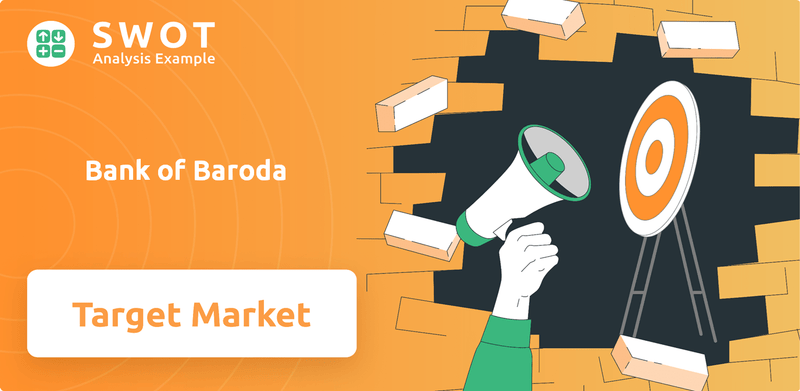
Bank of Baroda's success hinges on its ability to understand and cater to its varied customer base. This includes detailed insights into the bank's customer profile, including Bank of Baroda demographics by age and Bank of Baroda customer income levels. By examining Bank of Baroda's geographic target market and Bank of Baroda customer segmentation strategies, we can better understand its strategies for customer acquisition strategies and customer retention strategies within the competitive banking sector.
Who Are Bank of Baroda’s Main Customers?
Understanding the customer demographics and target market analysis is crucial for any financial institution. Bank of Baroda, with its extensive global presence, serves a diverse range of customers. This includes individuals, small and medium-sized enterprises (SMEs), and large corporations, making its customer segmentation strategies complex yet essential for growth.
The bank's ability to cater to both consumers and businesses highlights its strategic approach to capturing a broad market share. By examining the specific needs of each segment, Bank of Baroda can tailor its products and services effectively. This approach enables the bank to maintain its competitive edge within the banking sector.
As of March 2023, Bank of Baroda served approximately 165 million customers across 17 countries. The bank's focus on expanding its customer base is evident through its efforts to activate dormant accounts and fund zero-balance accounts, demonstrating a commitment to customer acquisition and retention strategies.
Bank of Baroda's B2C segment focuses on individual customers, offering a variety of retail advances. Retail advances have shown strong growth, increasing by 19.4% in FY25. This growth is driven by strong performance in auto loans, mortgage loans, home loans, and education loans, indicating a focus on individual customer needs.
The B2B segment of Bank of Baroda includes corporate banking and SME banking services. Credit to MSMEs increased by 14% to ₹131,769 crore as of December 2024, while corporate credit moved up 7% to ₹438,689 crore. The bank's Cash Management Services (CMS) business has also seen rapid growth, adding over 2,600 new relationships in FY 2023-24.
The share of Retail, Agri Loans, and MSME loans (RAM) in advances improved by 190 basis points year-on-year to 59.6% in FY25, with the RAM portfolio growing by 17.5%. Domestic CASA deposits grew 6.4% year-on-year to ₹4,96,462 crore as of March 31, 2025. These figures highlight the importance of these segments to the bank's revenue and growth.
With over 70,000 touchpoints across 17 countries on five continents, Bank of Baroda has a broad geographic reach. This global presence allows the bank to serve diverse customer demographics and adapt its strategies to different regional markets. Understanding the Bank of Baroda customer profile across these regions is crucial.
Bank of Baroda's approach to market segmentation is multifaceted, focusing on individuals, SMEs, and large corporations. The bank's success is tied to its ability to understand and meet the specific financial needs of each segment. Furthermore, the bank's focus on growing its CASA deposits and RAM portfolio demonstrates its commitment to a balanced and diversified portfolio.
- Retail advances, including auto, mortgage, home, and education loans, are a significant focus.
- B2B services include corporate banking and SME banking, with a focus on MSME credit growth.
- The bank's Cash Management Services (CMS) business supports large corporate and government customers.
- The bank's geographic reach spans 17 countries, allowing it to serve a diverse customer base.
For more details on how Bank of Baroda generates revenue, explore Revenue Streams & Business Model of Bank of Baroda.
Bank of Baroda SWOT Analysis
- Complete SWOT Breakdown
- Fully Customizable
- Editable in Excel & Word
- Professional Formatting
- Investor-Ready Format
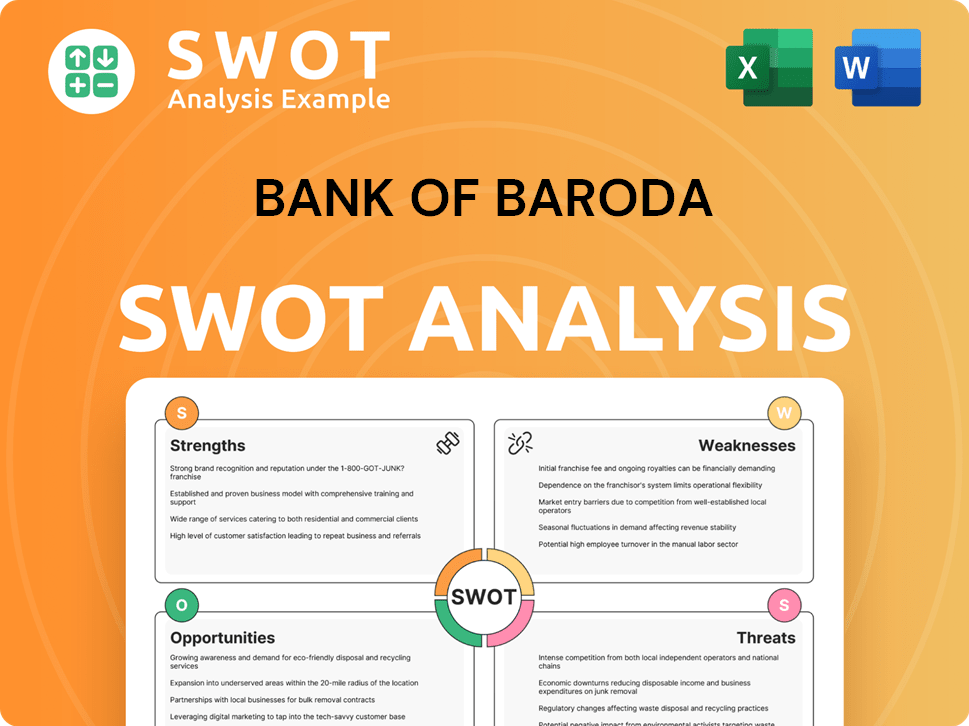
What Do Bank of Baroda’s Customers Want?
Understanding the needs and preferences of its diverse customer base is central to Bank of Baroda's strategy. This involves tailoring its offerings to meet various demands, motivations, and preferences across different customer segments. The bank's approach is data-driven, using customer feedback and market trends to refine its products and services continually.
Bank of Baroda focuses on providing accessible and convenient banking solutions for individual customers. Simultaneously, it caters to the specific needs of businesses, including SMEs and large corporations, through efficient financial management tools. This dual focus allows the bank to serve a broad spectrum of clients effectively.
The bank's commitment to digital transformation and customer-centric service is evident in its investments in digital channels and improvements to customer service. This ensures that Bank of Baroda remains competitive in the evolving banking sector.
Individual customers seek convenient and accessible banking options. The bank's focus on digital channels, like the bob World app, reflects this preference. This app had 306 lakh activations in FY 2024.
There's a strong demand for credit products that support major life goals. The growth in retail advances, particularly in home, auto, and education loans, demonstrates this. This indicates a need for financial solutions for significant purchases.
Customers prefer digital convenience and self-service banking. The bob World app facilitated 17.09 crore financial and 228.64 crore non-financial transactions in FY 2024. This caters to quick, on-the-go banking needs.
Competitive pricing is a key driver for customer attraction. Bank of Baroda offers cheaper rates than private sector banks. This attracts customers seeking affordable banking services.
Customers need secure and reliable banking services. Bank of Baroda's strong capital position and improving asset quality reflect this. Gross Non-Performing Assets (GNPA) improved to 2.26% and Net Non-Performing Assets (NNPA) to 0.58% as of March 31, 2025.
Businesses need efficient cash management, working capital, and expansion financing. The rapid growth of Cash Management Services (CMS) highlights this. Over 2,600 new CMS relationships were added in FY 2023-24.
Bank of Baroda integrates customer feedback and market trends into product development. It also focuses on improving service levels across branches. These actions help to ensure customer satisfaction and align with market demands.
- Digital Lending: Introduction of digital lending journeys for retail gold loans and Kisan Credit Card applications via the Jansamarth Portal.
- Partnerships: Collaborations with tech firms like Zopper and Optimum Solution to offer tailored digital insurance and investment solutions.
- Customer Service: Ongoing efforts to improve call center services with enhanced IVR functionalities and bundled product offerings.
- Service Audits: Monitoring service levels across branches through mystery shopping and service audits.
For detailed insights into the bank's strategic direction, consider reading about the Growth Strategy of Bank of Baroda.
Bank of Baroda PESTLE Analysis
- Covers All 6 PESTLE Categories
- No Research Needed – Save Hours of Work
- Built by Experts, Trusted by Consultants
- Instant Download, Ready to Use
- 100% Editable, Fully Customizable
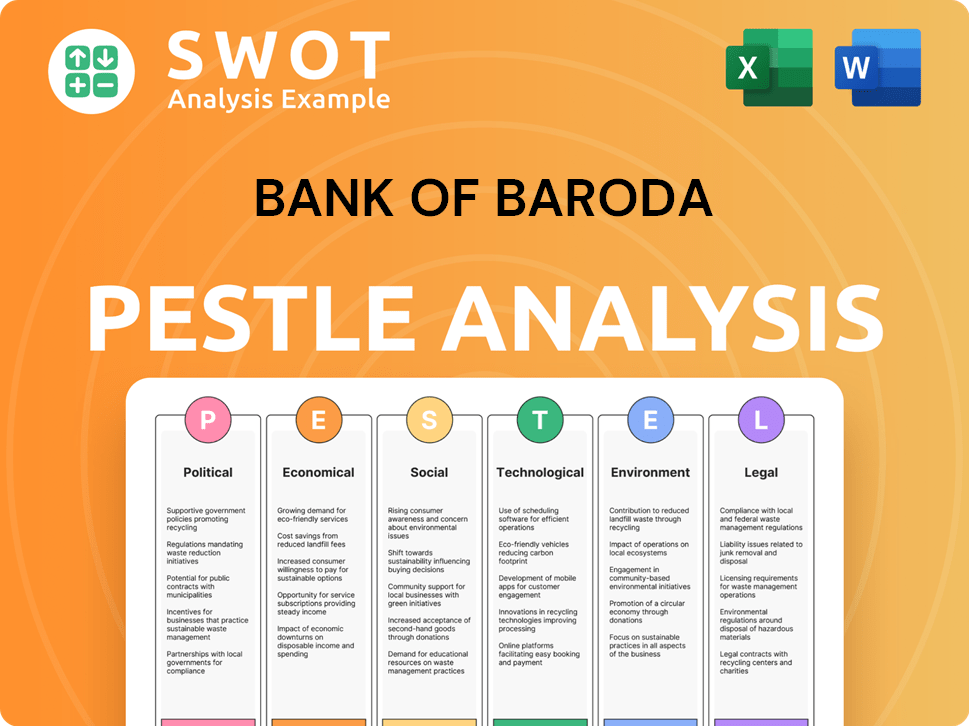
Where does Bank of Baroda operate?
Bank of Baroda's geographical market presence is extensive, encompassing both domestic and international operations. The bank has a robust presence in India, with a network of branches and ATMs across the country. Furthermore, it maintains a significant international footprint, serving customers across multiple continents.
As of March 2024, the bank had approximately 8,243 branches in India, covering 28 states and eight union territories. The international presence includes branches and offices in 17 countries across five continents. This diversified presence allows Bank of Baroda to cater to a wide range of customers and market segments.
The bank's strategic approach includes tailoring its services to local markets. For instance, the 'bob World UAE' mobile banking application is specifically designed for customers in the UAE. This localization strategy, along with its substantial branch network, contributes to its strong market position and customer reach.
In India, Bank of Baroda has a wide network of branches, with approximately 8,243 branches as of March 2024. These branches are spread across 28 states and eight union territories, ensuring a broad reach across the country. The extensive branch network supports a wide customer base and various banking services.
Bank of Baroda has a significant international presence with 91 overseas branches/offices spanning 17 countries across five continents as of March 2024. Key international markets include major financial centers such as New York, London, and Dubai. The international operations contribute significantly to the bank's global business.
Bank of Baroda holds a strong market share in the banking sector, with over 6% in both total assets and deposits as of March 31, 2024. The bank's international deposits grew by 15.8% year-on-year to ₹2,29,866 crore in March 2025, indicating robust growth in its global operations. This growth is supported by strategic market positioning and customer-focused initiatives.
The bank adapts its offerings to succeed in diverse markets. The 'bob World UAE' mobile banking application is a prime example of tailoring services to specific customer needs. The merger with Vijaya Bank and Dena Bank expanded its geographical presence and client base, demonstrating a commitment to strategic growth and market penetration. For more insights, see Marketing Strategy of Bank of Baroda.
Bank of Baroda Business Model Canvas
- Complete 9-Block Business Model Canvas
- Effortlessly Communicate Your Business Strategy
- Investor-Ready BMC Format
- 100% Editable and Customizable
- Clear and Structured Layout
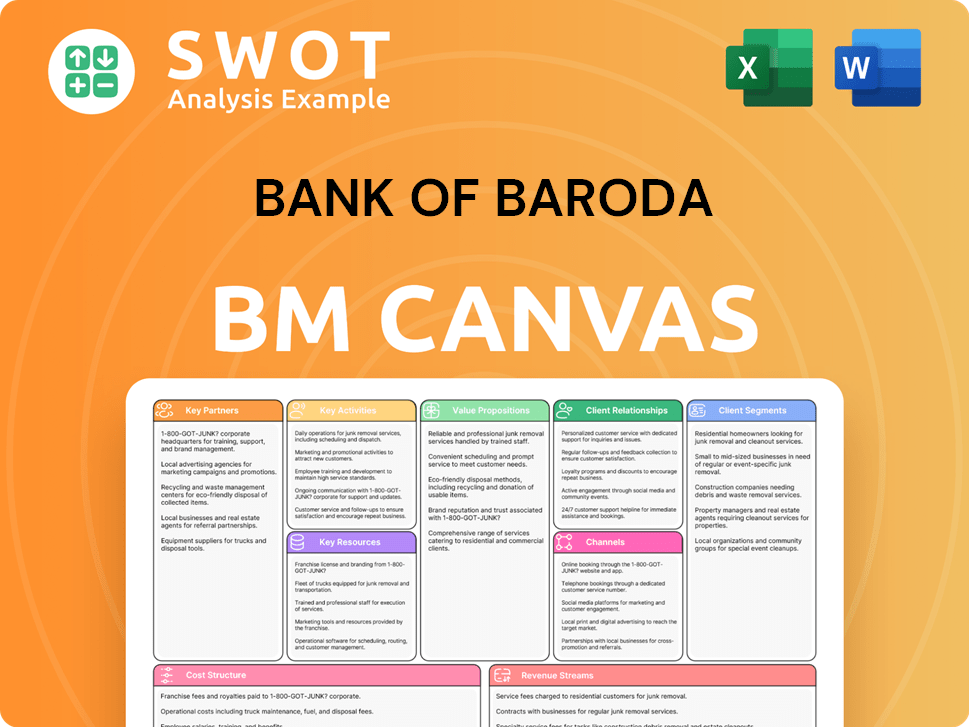
How Does Bank of Baroda Win & Keep Customers?
Bank of Baroda's (BoB) approach to customer acquisition and retention is multifaceted, blending traditional methods with digital innovation. This strategy focuses on attracting new customers while ensuring existing ones remain satisfied and engaged. Digital channels, particularly the bob World app, play a crucial role in expanding its customer base. The bank also emphasizes providing personalized services and a comprehensive range of financial products to foster customer loyalty.
The bank's digital transformation efforts have yielded significant results in customer acquisition. BoB has strategically invested in digital platforms and services, making banking more accessible and convenient for its customers. By leveraging technology, the bank aims to enhance customer experience and streamline various banking processes. This digital focus is complemented by efforts to improve service quality and offer competitive financial products.
Customer retention is a key focus for BoB, with initiatives designed to build trust and maintain customer satisfaction. The bank monitors service levels and actively works to activate dormant accounts, ensuring continuous customer engagement. Moreover, BoB's strong financial performance, reflected in reduced NPAs, contributes to customer confidence and loyalty, solidifying its position in the banking sector.
In FY 2024, BoB opened 1,02,299 Video Customer Identification Process (VCIP) savings bank accounts, 33,799 B3-digital accounts, and 2,44,582 current accounts through digital channels. A significant 82.11% of these accounts were opened via TAB mode. Furthermore, 66.92% of the 55,93,991 non-FI savings bank accounts were opened digitally.
The bob World app had 306 lakh activations and facilitated 17.09 crore financial and 228.64 crore non-financial transactions in FY 2024. This demonstrates the app's vital role in customer engagement and transaction processing. These figures highlight the app's importance in BoB's digital strategy.
BoB focuses on increasing the penetration of CASA (Current Account Savings Account) enablers, including POS systems and QR codes. This strategy aims to boost customer convenience and transaction volumes. Cash Management Services (CMS) business has been successful in acquiring corporate and government customers, adding over 2,600 new relationships in FY 2023-24.
The bank emphasizes personalized experiences and efficient service to retain customers. BoB monitors service levels through mystery shopping and service audits. Efforts to activate dormant accounts and fund zero-balance accounts contribute to re-engaging customers and boosting retention. The bank's strong asset quality, with reduced NPAs, builds customer trust.
BoB offers a complete banking product portfolio, serving as a one-stop shop for financial services. Competitive rates compared to private sector banks are a strong retention factor. Call center services are continuously improved with enhanced IVR functionalities, and bundled products are introduced to meet evolving customer needs.
- Consistent Growth: Domestic deposits increased by 9.3% year-on-year to ₹12,42,169 crore in March 2025, reflecting customer trust.
- Product Portfolio: A comprehensive range of banking services caters to diverse customer needs, enhancing loyalty.
- Competitive Pricing: Attractive rates compared to competitors help retain customers.
- Service Enhancements: Improved call center services and bundled products boost customer satisfaction.
Bank of Baroda Porter's Five Forces Analysis
- Covers All 5 Competitive Forces in Detail
- Structured for Consultants, Students, and Founders
- 100% Editable in Microsoft Word & Excel
- Instant Digital Download – Use Immediately
- Compatible with Mac & PC – Fully Unlocked
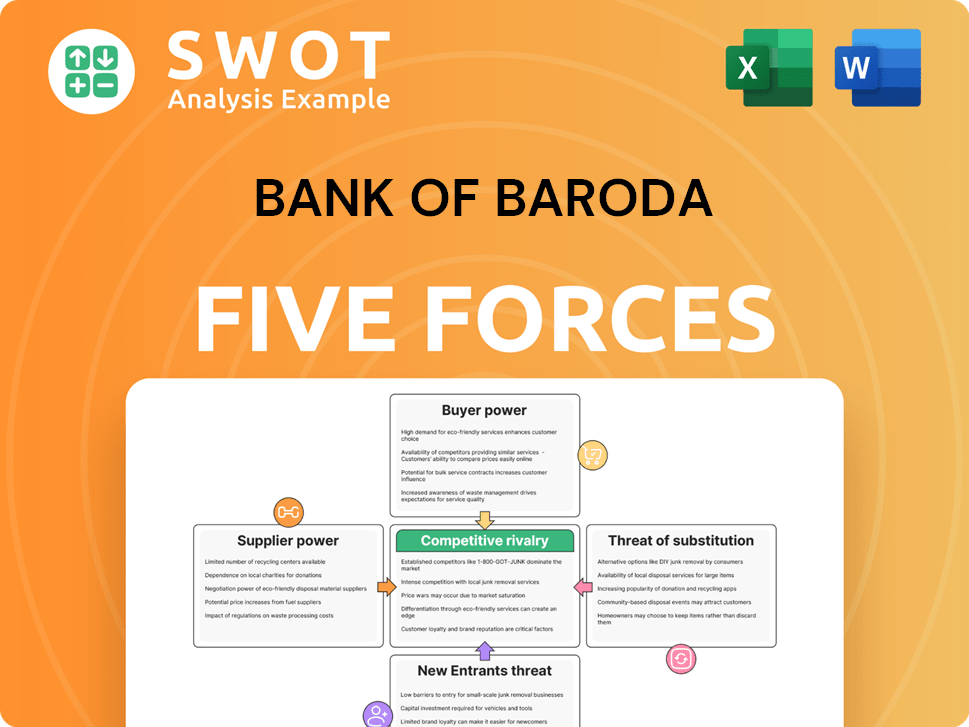
Related Blogs
- What are Mission Vision & Core Values of Bank of Baroda Company?
- What is Competitive Landscape of Bank of Baroda Company?
- What is Growth Strategy and Future Prospects of Bank of Baroda Company?
- How Does Bank of Baroda Company Work?
- What is Sales and Marketing Strategy of Bank of Baroda Company?
- What is Brief History of Bank of Baroda Company?
- Who Owns Bank of Baroda Company?
Disclaimer
All information, articles, and product details provided on this website are for general informational and educational purposes only. We do not claim any ownership over, nor do we intend to infringe upon, any trademarks, copyrights, logos, brand names, or other intellectual property mentioned or depicted on this site. Such intellectual property remains the property of its respective owners, and any references here are made solely for identification or informational purposes, without implying any affiliation, endorsement, or partnership.
We make no representations or warranties, express or implied, regarding the accuracy, completeness, or suitability of any content or products presented. Nothing on this website should be construed as legal, tax, investment, financial, medical, or other professional advice. In addition, no part of this site—including articles or product references—constitutes a solicitation, recommendation, endorsement, advertisement, or offer to buy or sell any securities, franchises, or other financial instruments, particularly in jurisdictions where such activity would be unlawful.
All content is of a general nature and may not address the specific circumstances of any individual or entity. It is not a substitute for professional advice or services. Any actions you take based on the information provided here are strictly at your own risk. You accept full responsibility for any decisions or outcomes arising from your use of this website and agree to release us from any liability in connection with your use of, or reliance upon, the content or products found herein.